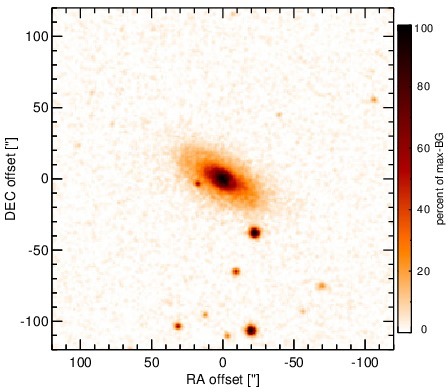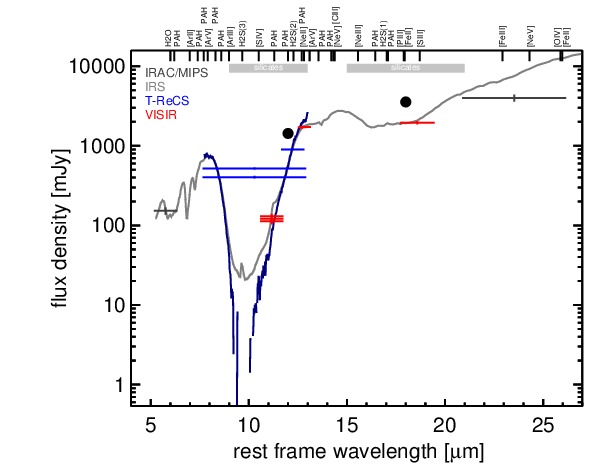Sasmirala Individual Information for NGC 4418
Description
NGC 4418 is an infrared-luminous inclined spiral galaxy at a redshift of z = 0.0073 (D ~ 37.8 Mpc) with a highly obscured active nucleus optically classified as a Sy 2.0 [veron-cetty_catalogue_2010]. The nucleus might also contain a compact massive starburst (e.g., [imanishi_near-infrared_2004, aalto_luminous_2007]); see [sakamoto_submillimeter_2013] for a recent detailed study). Owing to the high obscuration, the AGN is difficult to verify at X-ray wavelengths [maiolino_elusive_2003]. Radio observations show a compact high-brightness temperature core [condon_1.49_1990, kewley_compact_2000, baan_radio_2006]. A kiloparsec-scale outflow cone along a PA~ 15∘ was discovered [sakamoto_submillimeter_2013]. We conservatively treat NGC 4418 as an uncertain AGN. After the discovery of its infrared brightness with IRAS, NGC 4418 was followed up with ground-based MIR spectroscopy using UKIRT, which revealed an extremely deep silicate 10 μm absorption feature and the absence of any MIR emission lines [roche_ngc_1986]. These authors, for the first time, suggested the presence of a deeply buried AGN in NGC 4418. Ground-based MIR photometry [carico_iras_1988, wynn-williams_luminous_1993] and ISO observations [dale_iso_2000, spoon_obscured_2001, lu_infrared_2003] were subsequently performed. The first subarcsecond-resolution MIR images were obtained with Keck/MIRLIN in 1998 by [evans_compact_2003]. They show an unresolved nuclear source (except possibly at ~ 10 μm). The corresponding nuclear photometry demonstrates that the silicate absorption is originating in the projected central ~ 0.3arcsec ~ 60 pc. The nucleus is completely dominating the emission in the Spitzer/IRAC and MIPS PBCD images and saturates in the IRAC 8 μm band. The Spitzer/IRS LR staring-mode spectrum verifies the deep silicate 10 μm absorption and absence of PAH and ionic emission lines, while in addition revealing a strong silicate 18 μm absorption feature and a very steep red spectral slope in νFν-space (see also [dartois_carbonaceous_2007, stierwalt_mid-infrared_2013]). Thus, this arcsecond-scale MIR SED does not provide any direct indication of star formation activity and rather favours the presence of a buried AGN. However, the absence of any strong emission features indicates that putative MIR emission-line producing regions are heavily extincted (similar to, e.g., NGC 4945; [perez-beaupuits_deeply_2011]). The nuclear region of NGC 4418 was observed with T-ReCS in the N and Si6 filter in 2004 (unpublished, to our knowledge) and with VISIR in three N and one Q-band filter between 2005 and 2006 (PAH2 flux published in [siebenmorgen_nuclear_2008]). In all images, a compact MIR nucleus without further host emission was detected. It appears unresolved in the PAH2 images and possibly resolved in the Q2 image. However, in the other N-band images the apparent morphologies are contradicting and thus, we classify the general MIR extension as uncertain. Our remeasured PAH2 flux is consistent with [siebenmorgen_nuclear_2008], while the nuclear photometry generally is consistent with the Spitzer spectrophotometry, the T-ReCS LR N-band spectrum from [gonzalez-martin_dust_2013] and the previous MIR results. Therefore, we can verify that the deep silicate absorption features are originating in the projected central ~ 60 pc and correct our 12 and 18 μm continuum emission estimates accordingly.
- [aalto_luminous_2007] S. Aalto, R. Monje, and S. Martín. Luminous HC\3\N line and the HCN/HCO+ ratio in NGC 4418. buried AGN or nascent starburst? . A&A , 475 pp. 479–485, November 2007.
- [baan_radio_2006] W. A. Baan and H.-R. Klöckner. Radio properties of FIR-megamaser nuclei . A&A , 449 pp. 559–568, April 2006.
- [carico_iras_1988] David P. Carico, D. B. Sanders, B. T. Soifer, J. H. Elias, K. Matthews, and G. Neugebauer. The IRAS bright galaxy sample. III - 1-10 micron observations and coadded IRAS data for galaxies with l(IR) equal to or greater than 10 to the 11th solar luminosities . AJ , 95 pp. 356–373, February 1988.
- [condon_1.49_1990] J. J. Condon, G. Helou, D. B. Sanders, and B. T. Soifer. A 1.49 GHz atlas of the IRAS bright galaxy sample . ApJS , 73 pp. 359–400, July 1990.
- [dale_iso_2000] Daniel A. Dale, Nancy A. Silbermann, George Helou, Emmanuel Valjavec, Sangeeta Malhotra, Charles A. Beichman, James Brauher, Alessandra Contursi, Harriet L. Dinerstein, David J. Hollenbach, Deidre A. Hunter, Sonali Kolhatkar, Kwok-Yung Lo, Steven D. Lord, Nanyao Y. Lu, Robert H. Rubin, Gordon J. Stacey, Harley A. Thronson, Michael W. Werner, and Harold G. Corwin. ISO mid-infrared observations of normal star-forming galaxies: The key project sample . AJ , 120 pp. 583–603, August 2000.
- [dartois_carbonaceous_2007] E. Dartois and G. M. Muñoz-Caro. Carbonaceous dust grains in luminous infrared galaxies. Spitzer/IRS reveals a-C:H as an abundant and ubiquitous ISM component . A&A , 476 pp. 1235–1242, December 2007.
- [evans_compact_2003] A. S. Evans, E. E. Becklin, N. Z. Scoville, G. Neugebauer, B. T. Soifer, K. Matthews, M. Ressler, M. Werner, and M. Rieke. The compact nucleus of the deep silicate absorption galaxy NGC 4418 . AJ , 125 pp. 2341–2347, May 2003.
- [gonzalez-martin_dust_2013] O. González-Martín, J. M. Rodríguez-Espinosa, T. Díaz-Santos, C. Packham, A. Alonso-Herrero, P. Esquej, C. Ramos Almeida, R. Mason, and C. Telesco. Dust in active galactic nuclei. mid-infrared t-ReCS/Gemini spectra using the new RedCan pipeline . A&A , 553 pp. 35, May 2013.
- [imanishi_near-infrared_2004] Masatoshi Imanishi, Kouichiro Nakanishi, Nario Kuno, and Kotaro Kohno. Near-infrared and millimeter constraints on the nuclear energy source of the infrared-luminous galaxy NGC 4418 . AJ , 128 pp. 2037–2047, November 2004.
- [kewley_compact_2000] L. J. Kewley, C. A. Heisler, M. A. Dopita, R. Sutherland, R. P. Norris, J. Reynolds, and S. Lumsden. Compact radio emission from warm infrared galaxies . ApJ , 530 pp. 704–718, February 2000.
- [lu_infrared_2003] Nanyao Lu, George Helou, Michael W. Werner, Harriet L. Dinerstein, Daniel A. Dale, Nancy A. Silbermann, Sangeeta Malhotra, Charles A. Beichman, and Thomas H. Jarrett. Infrared emission of normal galaxies from 2.5 to 12 micron: Infrared space observatory spectra, near-infrared continuum, and mid-infrared emission features . ApJ , 588 pp. 199–217, May 2003.
- [maiolino_elusive_2003] R. Maiolino, A. Comastri, R. Gilli, N. M. Nagar, S. Bianchi, T. Böker, E. Colbert, A. Krabbe, A. Marconi, G. Matt, and M. Salvati. Elusive active galactic nuclei . MNRAS , 344 pp. L59–L64, October 2003.
- [perez-beaupuits_deeply_2011] J. P. Pérez-Beaupuits, H. W. W. Spoon, M. Spaans, and J. D. Smith. The deeply obscured AGN of NGC 4945. i. spitzer-IRS maps of [ne v], [ne II], h2 0-0 s(1), s(2), and other tracers . A&A , 533 pp. 56, September 2011.
- [roche_ngc_1986] P. F. Roche, D. K. Aitken, C. H. Smith, and S. D. James. NGC 4418 - a very extinguished galaxy . MNRAS , 218 pp. 19P–23P, January 1986.
- [sakamoto_submillimeter_2013] Kazushi Sakamoto, Susanne Aalto, Francesco Costagliola, Sergio Martín, Youichi Ohyama, Martina C. Wiedner, and David J. Wilner. Submillimeter interferometry of the luminous infrared galaxy NGC 4418: A hidden hot nucleus with an inflow and an outflow . ApJ , 764 pp. 42, February 2013.
- [siebenmorgen_nuclear_2008] R. Siebenmorgen, M. Haas, E. Pantin, E. Krügel, C. Leipski, H. U. Käufl, P. O. Lagage, A. Moorwood, A. Smette, and M. Sterzik. Nuclear activity in nearby galaxies. mid-infrared imaging with the VLT . A&A , 488 pp. 83–90, September 2008.
- [spoon_obscured_2001] H. W. W. Spoon, J. V. Keane, A. G. G. M. Tielens, D. Lutz, and A. F. M. Moorwood. The obscured mid-infrared continuum of NGC 4418: A dust- and ice-enshrouded AGN . A&A , 365 pp. L353–L356, January 2001.
- [stierwalt_mid-infrared_2013] S. Stierwalt, L. Armus, J. A. Surace, H. Inami, A. O. Petric, T. Diaz-Santos, S. Haan, V. Charmandaris, J. Howell, D. C. Kim, J. Marshall, J. M. Mazzarella, H. W. W. Spoon, S. Veilleux, A. Evans, D. B. Sanders, P. Appleton, G. Bothun, C. R. Bridge, B. Chan, D. Frayer, K. Iwasawa, L. J. Kewley, S. Lord, B. F. Madore, J. E. Melbourne, E. J. Murphy, J. A. Rich, B. Schulz, E. Sturm, V. U, T. Vavilkin, and K. Xu. Mid-infrared properties of nearby luminous infrared galaxies. i. spitzer infrared spectrograph spectra for the GOALS sample . ApJS , 206 pp. 1, May 2013.
- [veron-cetty_catalogue_2010] M.-P. Véron-Cetty and P. Véron. A catalogue of quasars and active nuclei: 13th edition . A&A , 518 pp. 10, July 2010.
- [wynn-williams_luminous_1993] C. G. Wynn-Williams and E. E. Becklin. Luminous infrared galaxies - sizes at 10-32 microns . ApJ , 412 pp. 535–540, August 1993.
Images

Optical image (DSS, red filter). Displayed are the central 4 arcmin with North being up and East to the left. The colour scaling is linear with white corresponding to the median background (BG) and black to the 0.01% pixels with the highest intensity.

Spitzer MIR images. Displayed are the inner 40 arcsec with North being up and East to the left. The colour scaling is logarithmic with white corresponding to median BG and black to the 0.1% pixels with the highest intensity. The label in the bottom left states instrument and central wavelength of the filter in micron (I: IRAC, M: MIPS).

Subarcsecond-resolution MIR images sorted by increasing filter central wavelength. Displayed are the inner 4 arcsec with North being up and East to the left. The colour scaling is logarithmic with white corresponding to median BG and black to the 75% of the highest intensity of all images in units of sig_bg. The inset image (where present; either bottom or top right) shows the central arcsecond of the PSF from the calibrator star, scaled to match the science target. The labels in the bottom left state instrument and filter names (C: COMICS, M: Michelle, T: T-ReCS, V: VISIR).
SEDs


MIR SED. The description of the symbols in all the SED plots (where present) is the following: Grey crosses and solid lines mark the Spitzer/IRAC, MIPS and IRS data. The colour coding of the other symbols is as follows: green for COMICS, magenta for Michelle, blue for T-ReCS and red for VISIR data. Darker-coloured solid lines mark spectra of the corresponding instrument. The black filled circles mark the nuclear 12 and 18 micron continuum emission estimate from the data (where present). The ticks on the top axis mark positions of common MIR emission lines, while the light grey horizontal bars mark wavelength ranges affected by the silicate 10 and 18 micron features.